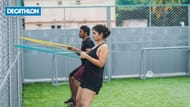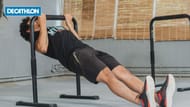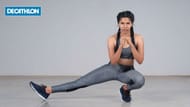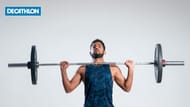If you are looking for a healthy and fit Olympian body and are willing to work hard for it, you have come to the right place. Here, you will learn how an Olympian Athlete trains, the hours of training, the various kinds of training, the diet they follow, the sports goods they use, and lifestyle habits that contribute to their fitness and health, and the product recommendations you can follow to train just like them! Here’s a list of gear from Decathlon to get you started.
You could also start by attending workshops and events with Allforsport by Decathlon to train with experts across multiple sports.
Introduction:
Olympics is a huge sports event that has its audience glued to their seats and leaves them in awe of the athletic spirit and prowess of the participating athletes. But have you ever wondered what goes into becoming an Olympics athlete? From wrestling to swimming and archery and so on, each athlete taking part in one of the biggest sports events has to adopt a strict lifestyle which helps them keep fit and strong. They look so perfectly athletic, everything they do seems like a piece of cake. But in reality, they spend hours in the gym, follow a strict and clean diet and do so much more than regular athletes.
Each Olympics athlete works hard to bag a medal in this mega event. It isn't just that most Olympians are blessed with a unique set of physiological abilities, though that's a significant part of it. It's also about their dedication to their sports and, perhaps most importantly, how they prepare for them. In this article, we will be talking about all the things that go into the making of such passionate minds and the tough bodies of Olympian athletes. Keep reading to find out tips and tricks on how to train like an Olympian athlete.
How To Train Like An Olympian Athlete?
For an easy understanding, we have divided this segment under the following heads:-
1. Hours Of Training In A Day
There is no set training regimen for Olympic athlete training. The quantity of time spent training differs for each individual and is determined by the sport, the athlete, and the time of year. Simone Biles of the United States has previously stated that she trains for 32 hours per week, with just one day off. Gymnast Gabby Douglas has stated that she trains from 8AM until lunchtime, has her lunch, and then trains again till dinnertime. Research published before the 2012 London Olympics revealed that some participants had put in 10,000 hours of training before the Games.
2. Type Of Training
If you’re wondering how to train like an olympian athlete, the fact is that they devote a significant quantity of time to training to achieve a peak physical state. Their training is well-rounded. Regardless of the sport, varying training can enhance qualities such as strength, stamina, flexibility, and speed. While Olympians participate in specific events, their preparation generally includes training in multiple disciplines. If you do the same routine every day or regularly, you will gradually incur overuse issues. As a result, the tendons, soft tissue, and bones may get strained and suffer damage or degradation. Changing up your workout strategy can help reduce your chances of certain types of injuries. They do not lose sleep.
Apart from varied intensive training and workouts, they also make sure to sleep well. Sound sleep helps in developing a sound and healthy body. Some of the Olympic athletes sleep 8-10 hours a day. Your body recovers and relaxes as you sleep so it is rather crucial to have a goodnight’s sleep.

3. Time Of Training
Olympic athletes work out first thing in the morning. But, how to train like an Olympian athlete if you have a busy schedule? Well, if they can make it happen, so can you. You are far less prone to get disturbed by interruptions early in the morning, and you will feel amazing all day.
4. Advantages Of Training
Proper athletic training, one like an Olympian, has its benefits. Even if you are not planning to participate in the Games, training like on Olympian has its advantages:
a) It prevents back injury or pain. It is an issue that a lot of people are facing these days. So, staying fit and working out properly is very helpful for back issues.
b) Athletic training improves lower body strength and coordination. Lower body strength and coordinating training are omitted in a lot of weight-loss regimens. Therefore, a well-rounded training like an athlete is really important to perform daily activities without any discomfort.
c) It also creates upper body symmetry. Front-to-back and side-to-side symmetry helps us function better in our everyday lives and also aids in avoiding injuries, and not to forget, creates muscular strength.

5. Regularity Of Training
The very essence of any type of workout or training is consistency. You should be consistent and regular to see desired results. Olympians, as well, are very regular with their workouts and training. But taking time off is non-negotiable. At least one off day in a week is necessary for the body, but that doesn’t mean they just lie around. They do something productive and light, for example, a cycle ride for a while or a short hike.
Workouts And Fitness Secrets Of Olympic Athletes:
While Olympic athletes represent the peak of athletic greatness, there are certain Olympic training "secrets" that can benefit any fitness regime, regardless of the ability.
1. Diet
To achieve Olympic-level performance and unmatched energy, you must eat appropriately, beginning with a breakfast of complex carbs and lean protein, and continuing to eat every 3-4 hours and within 90 minutes of workout. Drink half your weight in fluid amounts of pure water, and if training vigorously or for an extended duration, drink a sports drink to replace electrolytes. Nutrition is an important aspect of healing. Ensure that you are fueling up properly. If you don't have much time, you should think about preparing meals so you don't have to grab food on the go. It is vital to have a healthy eating plan to complement your workout.
Athletes preparing at one of the U.S. Olympic Athlete Training Center's facilities meet with a crew-usually nutritionist, athletic trainer, sports medicine expert, and trainer-to examine their strengths and limitations and adjust their diets, overloading, and recovery strategies appropriately. More training programs will be included in an athlete's program if, for example, their overall fitness does not meet standards. Iron levels may be examined in athletes who are experiencing weariness.
2.Exercises
Do we often come across this question as to how to train like an Olympian athlete? Well, here are a few things to get you started.
a) Proper warm-ups and recovery
Spend 10-15 minutes on dynamic warm-ups like skipping or reverse lunges after 10 minutes of mild jogging or jumping rope to enhance flexibility, balance, and rhythm, as well as to avoid injury. After your workout session, use recovery treatments such as foam rolling, massages, and stretching/flexibility exercises to keep your body flexible and relieve pain.

b) Make use of a variety of energetic workouts
Rather than using fixed pieces of equipment, incorporate diagonal and rotating movements, as well as unilateral exercises, with medicine balls or Swiss Balls in your Olympic athlete workout.
c) Lift heavyweights
You should push yourself to achieve maximal strength improvements to percent be exceptional. Once a week, do 2-3 sets of a "heavy" lift with 4-6 reps. Lifting heavy will enhance hormonal activity in addition to making you stronger.

d) Pull up power
Since our backs are made up of massive muscles, pull-ups will allow you to run faster, enhance your posture, and boost your metabolism. Using a Super Band, having a friend assist you, and using a rowing machine are all good ways to enhance or work up to a proper pull-up.

Olympic Sports Goods - A Complete Guide:
More athletes across more sports are shifting to high-tech devices, clothes, and shoes, testing and evaluation to gain the upper hand in the competition. Advances in basic sports supplies, such as a soccer ball, are boosting the efficacy of all competitors. Aerodynamic tracksuits created with recyclable materials, super-light running shoes, and outfits that compress the muscles for greater control and efficiency are examples of high-tech apparel. High-tech sensors that evaluate a swimmer's kick while training and egg-shaped pods that athletes sit in to help them absorb oxygen more smoothly are examples of hidden innovations.
In a study, Haake and other researchers looked at swimming, a sport in which full-body swimsuits improved speed by up to 3.5 per cent in the men's freestyle in 2008. Critics debated whether science had gone too far because swimmers using those high-tech suits broke an exceptionally high number of records.
At the Olympics, changes to sports goods are typical. A soccer ball with thermal-bonded joints gave sportsmen a rounder ball for better passing accuracy. British bikers used tight-fitting bicycle helmets built from 3D scans to reduce wind resistance. Speakers placed behind each sprinter at the start position ensure that everyone hears the beginning shot at the same time. According to sports experts, each sport must strike a balance between traditions and modern tech to evolve. Sports that do not evolve are at the risk of losing their popularity and significance.
Here’s a list of product recommendations for you that most Indian Athletes swear by, in case you are interested in sports or just regular gym workouts
2. Mats
6. Cycles
9. Basketball
Frequently Asked Questions:
1. How long does it take to become an Olympic athlete?
While there are exceptions, coaches and instructors say it is usual for athletes to devote four to eight years of preparation before making it to an Olympic team.
2. How many hours a day does an Olympic athlete train?
Indian athletes train for approximately 5 to 6 hours a day, 6 days a week.
3. At what age do Olympic athletes start training?
According to one study, Olympic athletes must train for eight to nine years before mastering their sport completely.
Being an athlete is hard and being an Olympic athlete is even more challenging. It requires a lot more than just physical training and lifestyle changes and transforms a person’s mental and emotional being. Set goals and benchmarks for yourself and do not expect immediate results because changes don’t happen overnight, you have to work for it. Thinking like an Olympian may enable you to get the most out of every session, no matter what you are training for. When you are losing strength or inspiration, remember how much dedication it takes to make it to the Olympics. Even a small amount of that discipline can help you get through each day.
If you liked this article, head over to Decathlon Blog for more such content on practice.
